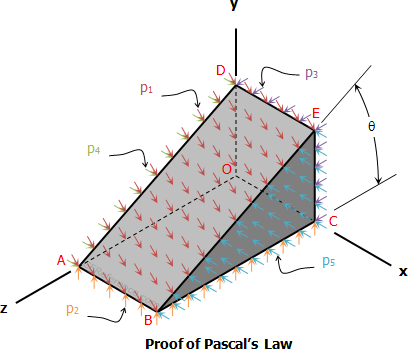Principles of Hydrostatic Pressures
Unit Pressure
Unit pressure or simply called pressure is the amount of force exerted by a fluid distributed uniformly over a unit area.
If the unit pressure is not uniform over the unit area, it can be expressed as the sum of differential pressure.

Blaise Pascal (1623 – 1662)
Since fluid at rest cannot resist shearing stress, pressure is always at right angle to the area where it is acting. It is also worthy to note that the total hydrostatic force F = pA, which can be found by cross multiplication.
Pascal’s Law
The French mathematician Blaise Pascal (1623 – 1662) states that the pressure is the same in all directions at any point in a fluid at rest.
From the figure shown below, summation of forces in y-direction:
$\Sigma F_y = 0$
$p_2A_{ABCO} = (p_1 A_{ABED}) \cos \theta $
$p_2A_{ABCO} = p_1 (A_{ABED} \cos \theta)$
Since $A_{ABCO} = A_{ABED} \cos \theta$, $p_2 = p_1$.

Summation of forces in z-direction:
$\Sigma F_z = 0$
$p_3A_{OCED} = (p_1 A_{ABED}) \sin \theta$
$p_3A_{OCED} = p_1 (A_{ABED} \sin \theta)$
Since $A_{OCED} = A_{ABED}\sin \theta$, $p_3 = p_1$.
Thus,
$p_1 = p_2 = p_3$ which can be used to conclude Pascal's Law.
Summation of forces in x-direction:
$\Sigma F_x = 0$
$p_4A_{AOD} = p_5A_{BCE}$
Since $A_{AOD} = A_{BCE}$, $p_4 = p_5$.
Atmospheric, Gauge, and Absolute Pressures
Atmospheric pressure is the weight of all gasses above the surface in which it comes in contact. Under normal conditions, atmospheric pressure at sea level is equal to 101.325 kPa (14.696 psi), usually rounded off to 100 kPa (14.7 psi) by engineers. With increase in altitude, atmospheric pressure decreases.
Gauge pressure, measured with the use of pressure gauges, is the pressure above or below atmospheric pressure. Negative gauge pressure indicates a vacuum which cannot go below –101.325 kPa. Positive gauge pressure indicates that the pressure is above atmospheric. Gauge pressure is also called relative pressure.
Absolute pressure is equal to gauge pressure plus atmospheric pressure. There is no such thing as negative absolute pressure. In the absence of all matter (complete vacuum), the absolute pressure is zero.
Back to top
Pressure Gauges
Just for the purpose of completeness of this page, pressure gauges (or pressure instruments) are listed here. For more detailed discussion about pressure gauges, refer to the links in each type of pressure instrument. Some general types of pressures instruments are as follows.
- Barometer - used to measure atmospheric pressure. Wikipedia article.
- Manometer - a U-tube that contains liquid of known specific gravity. Wikipedia article.
- Bourdon gauge - used to measure large pressure difference. Integrated Publishing article.
- Log in to post comments
